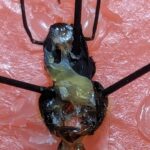Lost In The Yellow? (3/13/24)
Welcome back!!
Spring break was a lot of fun, but it’s nice to be back in the lab! Before jumping straight into data collection, I decided to run through some dissections with a couple of practice bees to make sure I remembered everything after having time off. Once I felt confident in my dissection skills again, I started back with the control bees at 2 hours. I have dissected the last ten of them, making their overall average now 0.00097mm2. The main reason for a decrease in size for the control from 0 hours to 2 hours is likely that when the bees are stressed( from being caged and hand fed) they release hormonal signals that cause their glands to begin to degrade (Deeter, et al, 2023). I have also finished 5 more dissections from the pyriproxyfen group at 2 hours, and the results so far are showing significance, which is great!! I have 5 more to dissect today, before I can fully make a conclusion, but it is looking like the pyriproxyfen is affecting their hypopharyngeal gland size. The current average for the pyriproxyfen group at 2 hours is 0.00076mm2.
Something interesting that I have noticed is that many glands in the 2 hour groups (both the control and pyriproxyfen) appear fully yellow or have a yellowish tint. I have done my best to record how yellow the glands are from every bee I dissect, but I did not do this for some of the bees at the beginning, as I had not yet noticed it or it had not yet been present. I have been messing around with different data points, trying to determine if there is some correlation with size or time to the gland’s yellowness. It is difficult though because I have to try to represent the amount of yellow as a number, instead of a qualitative value. But, if I find something significant, I will post about it in the following weeks. For now here is a picture of some very yellow glands from a bee 2 hours after the pyriproxyfen treatment.
Additionally, my onsite mentor and I have begun to discuss multiple different options for moving forward with this research. There are two different things that I’ve decided to pursue. First off, in the original research thesis (Deeter et al, 2023) that I developed my research question from there was not one, but two pesticides used: pyriproxyfen, the insect growth regulator that I have been studying, and spirodiclofen. In Deeter’s research it had been shown that spirodiclofen did cause a significant change in the abdominal lipid body of bees, but pyriproxyfen did not, which is why I have been looking into if pyriproxyfen affects their other main lipid stores, the hypopharyngeal glands. Even though the spirodiclofen does affect their abdominal lipid stores, that does not mean that only the abdominal stores are affected. So, my next step will be to look at bees 2 hours after being treated with spirodiclofen. In addition to this, I will be looking at the raw data from Deeter’s results to determine a relative proportion for how much the hypopharyngeal glands degrade to how much the hemolymph levels(lipids in the blood) increase.
Thank you for reading!
-Juliette


